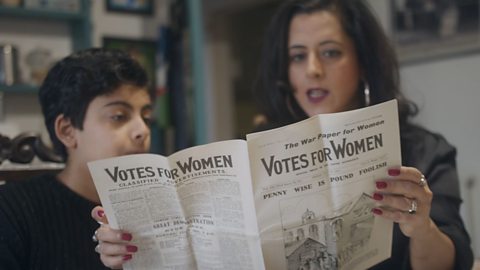Rohit:
My name is Rohit. I'm 15 years old and I live in Edinburgh in Scotland. I've come to see my friend Hermann, who's a photographer. Hermann is from India, like my family, and has been taking pictures of South Asian communities living in Scotland ever since he arrived here over 30 years ago.South Asia includes India, Pakistan and Bangladesh. These countries used to be part of the same country known as British India, because it was ruled by Britain. But many of the people living there did not want to be ruled by the British or be part of the British Empire. They wanted to govern themselves. So in August 1947, British India became independent and split into two new countries, India and Pakistan. This was known as the partition. After partition, many people moved from India and Pakistan to the UK. Because they heard there were opportunities to work and to have a better future here.Some of those people settled in Scotland and worked in the mills of Dundee and the buses and trains in Glasgow. Some opened small shops and businesses and some became doctors, nurses and teachers. Now there are more than 55,000 people of South Asian origin living in Scotland.So when did you first come to Scotland?
Hermann:
I came to Scotland in 1990. I came from Jaipur in northwest India. My wife came to do a PhD at the University of Edinburgh, so I accompanied her. When I first came here I noticed that the Asian community had held on to their Asian cultural identity at the same time they were being Scottish.
I was curious to see why people from South Asian countries that came from hot climates would decide to choose cold, windy Scotland as their home and I decided to photograph them just to bring about this fusion of cultures. When I first started going to Asian gatherings. I was very curious to see how colourful, vibrant the people were. I started realising that one day they were full of Asian colours, Asian dresses, and the next day they were celebrating living in Scotland with the Scottish culture.And I wanted to portray that in my photography. So I carried my camera everywhere I went, and I started recording their lives, their culture, their religions, their celebrations, to bring to people the sheer variety and joy and colour of the community.
Rohit:
How long have South Asian people been living in Scotland?
Hermann:
Scotland's had the South Asian community from the late 1880s. The first recorded Edinburgh Indian Association goes as far back as 1883. That was British India. But in 1947 there was a partition. People move from India and Pakistan to Scotland to earn a better living and support their families.
Rohit:
So how have things changed since you've been here?
Hermann:
The community has changed drastically because the demands have changed. Earlier people came to make a living to support their families. But now Scotland needs South Asians for their work in I.T., for their work in medicine, and several other employment opportunities. And there are some people with wealth and money who come and settle in Scotland just because they like the rural Scottish lifestyle.
Rohit:
What has been the best thing about being a photographer?Hermann:
It has made me aware of all the cultures that are available in South Asia, that people living in Scotland imbibe and follow. I'm also fascinated because of the connection between Scotland and India. There are towns and there are regions that are named after Indian towns and regions within Scotland. This is a picture of a sign for a town in East Ayrshire called Patna. Patna's named after a very big town in the northeast of India. It's interesting because the town was set up by a man who made a fortune trading in Patna rice, and you'd be surprised to know even the logo for the Patna school is a sheaf of rice.The two cultures are so well connected that there are Asian families in Scotland that have their own tartan. It's fascinating to discover so many South Asian cultures thriving in Scotland.
Rohit:
Hermann and his photographs have shown me a side of Scotland that most people don't get to see. I feel very lucky that my family made the journey from India to Scotland all those years ago, so I get to grow up being Scottish and Indian.
Video summary
Photographer Hermann Rodrigues talks to 15 year-old Rohit about the South Asian communities that migrated to Scotland.
South Asia includes India, Pakistan and Bangladesh. These countries used to be part of the same country known as British India, because it was ruled by Britain. In August 1947, British India became independent and split into two new countries, India and Pakistan.
After the Partition of India, many people moved from India and Pakistan to the UK, with many settling in Scotland and working in the mills of Dundee and on the buses and trains in Glasgow.
Hermann talks about how curious he became to see why people from South Asian countries, with hot climates, would decide to choose cold, windy Scotland as their home. He wanted to capture this fusion of cultures in his photographs.
Hermann was fascinated to discover so many South Asian cultures thriving in Scotland and how the two cultures are so well connected that there are Asian families in Scotland that have their own tartan.
This short film is from the ΒιΆΉΤΌΕΔ Teach series British Asian History.
Teacher Notes
Learning points
- To learn about the reasons why people have emigrated to Britain from Asia over time, and in the post-war years.
- To learn the effects of India becoming independent from Britain in 1947, just after WW2.
- To understand the idea of the βdual identityβ of people who migrate from one country and settle in another (being Scottish and also Indian).
Key Vocabulary
This film gives you the chance to explore and learn this vocabulary in the context of a personal story.
Vocabulary used in the film:
- Origin
- Ruled
- British Empire
- Independent
- Garments
- Kilt
- Tartan
- Privilege
- Variety
- Opportunities
- Wealth
- Mills
- Partition of India
Vocabulary useful for discussing the film:
- Immigration and immigrants - coming to live permanently in another country.
- Emigration - leaving one's own country in order to settle permanently in another.
- Asia/Asian - the largest and most populous continent on earth.
- Britain/ British - "Great Britain" is often used to refer to England, Scotland and Wales, including their component adjoining islands.Great Britain and Northern Ireland now constitute the United Kingdom.
- Community - a group of people living in the same place or having a particular characteristic in common.
- Culture - a pattern of behaviour shared by a society, or group of people.
- Discrimination - the unjust or prejudicial treatment of different categories of people.
- Diversity - differences in racial and ethnic, socioeconomic, geographic and academic backgrounds.
- Equality - when people are treated the same, regardless of what they look like or where they come from.
- Inclusion - being a part of what everyone else is, being welcomed and embraced as a member who belongs.
- Legacy - something we inherit from past generations and pass to our future generations.
- Prejudice - a preconceived opinion that is not based on reason or actual experience.
- Racism - the belief that people of different races or ethnic groups have different value in society, and using this against them.
Before watching the film
You may want to discuss what your pupils understand by the word βimmigrantβ and what they already know about people who have come to live in the UK, over time. Pupils could discuss what they understand by the term βcommunityβ and whether they identify as being part of any communities.
Hermann talks about the causes and effects of the Partition of India. He talks about the connection between the Partition and the British Empire. You could make links between the pupilsβ prior history knowledge of this time.
Please note, you should consider the needs of any children in your class with Pakistani or Indian heritage, or who have lived experience of being displaced or having to leave a country under distressing circumstances, as part of your preparation.
Questions to consider
Depending on the focus of your lesson, you may wish to pause the short film at certain points to check for understanding, asking questions such as:
- Why did some people move from South East Asia to Scotland after the Partition of India? What were the challenges and opportunities for these people?
- Why did Hermann move to Scotland?
- Why do you think Hermann likes photographing Asian people in Scotland?
- Hermann is very positive about the variety of people living in Scotland. What reasons does he give in the film for it being positive that Asian people have moved to Scotland?
Activities to further explore learning
- Pupils could compare and contrast this episode with the Moey Hassan episode.
- Pupils could discuss how our British Values feature in Hermannβs story. For example, how is tolerance or intolerance a part of this film?
- Having watched the film, pupils could write down any questions they would ask Hermann if they had the opportunity.
How this film meets the aims of the National Curriculum in England:
- History
This film will help you to ensure your pupils understand the history of these places as a coherent, chronological narrative, focusing on the 19th Century to the present day. Through this personal story, pupils will learn about the diversity of people who have shaped this nation and how Britain has influenced and been influenced by the wider world.
Pupils will develop deeper understanding of historical concepts such as continuity and change, cause and consequence, similarity, difference and significance, and use them to make connections, draw contrasts, analyse trends, and frame historically-valid questions.
They will also gain historical perspective by placing their growing knowledge into different contexts, understanding the connections between local, regional, national and international history; between cultural, economic, military, political, religious and social history; and between short- and long-term timescales.
How this film meets the aims of the Scottish Curriculum:
Social Studies
This film will enable pupils to compare and contrast communities and the lives of people in the past with their own, and to contribute to a discussion of the similarities and differences.They will find out why people and events from a particular time in the past were important, placing them within a historical sequence.
Health and Welbeing Across the Curriculum
This film will help pupils to develop self-awareness, self-worth and respect for others, understanding diversity and that it is everyoneβs responsibility to challenge discrimination.
How this film meets the aims of the The Northern Ireland Curriculum:
- The World Around Us
This film will enable pupils to learn about how people and places have changed over time, the causes and effects of people moving from one place to another, and the positive and negative impacts of people on places. Exploring the lives and memories of people from the past is part of the history non-statutory guidance and this film provides an ideal starting point for this.
- Personal Development
This film will enable pupils to appreciate the similarities and differences between themselves and others by providing a starting point for discussing cultural heritage, community and the diversity of people living in Britain.
How this film meets the aims of the National Curriculum in Wales:
History
This film will enable pupils to place events chronologically, identify similarities and differences between ways of life in different places during the 20th Century, and to discuss the consequences to people of historic events.Personal and Social Education Framework
This film will help pupils to see people who have been active citizen and help them to develop respect for others. Through personal stories, pupils will learn the value of diversity and recognise the importance of equality of opportunity.
Zi Lan Liao - Chinese migration to Britain. video
Music teacher, Zi Lan, talks to 10 year-old Cherie about how she came to Liverpool as a child and why people emigrated to Britain from Asia.
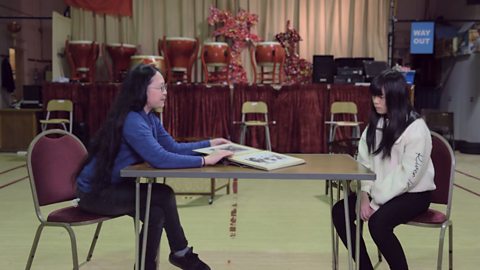
Ganesh Rai - The Gurkhas contribution to the British army. video
Eight-year-old Reva talks to Captain Ganesh Rai about the contribution of Gurkha soldiers to the British army over the past 200 years, especially during World war Two.

Noor Inayat Khan - Britain's first muslim war heroine. video
Author Shrabani Basu tells 14 year-old Iman about the life of Noor Inayat Khan, Britain's first muslim war heroine.
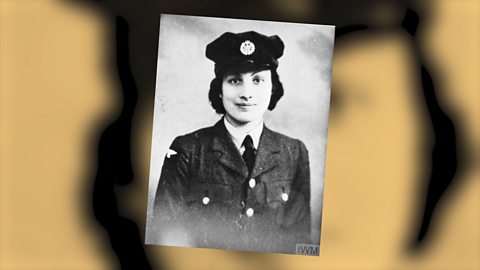
Anna Nguyen - Vietnamese migration after the Vietnam War. video
Artist Anna Nguyen talks to 11 year-old Vincent about the Vietnamese migration to Britain after the war between North and South Vietnam.

Marigin Opiala - Migrating from the Philippines to work for the NHS. video
In this short film for primary schools Marigin Opiala talks to 15-year-old Bea about why she moved to the UK, along with thousands of other Filipino nurses, to work for the NHS.
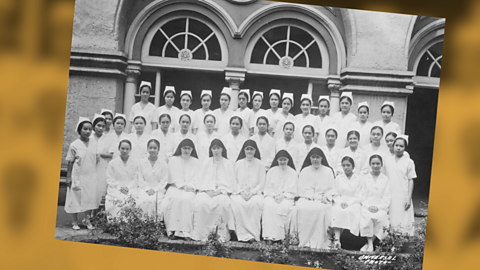
Moey Hassan - Pakistani migration to the UK. video
Actor and musician Moey Hassan talks to his nephew, 10 year-old Yusef, about the Pakistani migration to the UK.
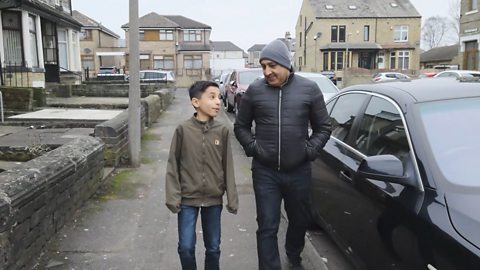
Rupal Rajani - The forced migration of Indian people from Uganda. video
Radio DJ Rupal Rajani talks to 10-year-old Ayush about how Indian people living in Uganda in the 1970's were forced to leave by the Ugandan President Idi Amin.
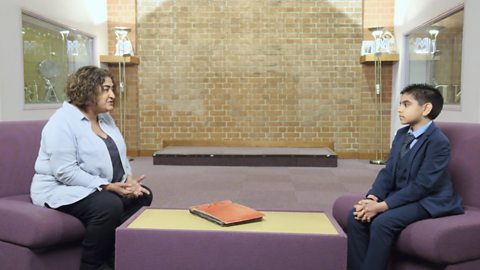
Sophia Duleep Singh - The Indian Princess who helped women gain the right to vote. video
11 year-old Hari talks to his mum about an Indian princess called Sophia Duleep Singh, who helped women in the UK gain the right to vote.
